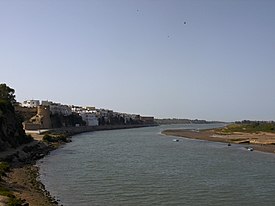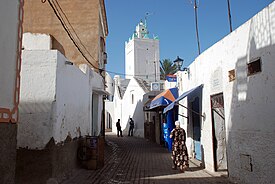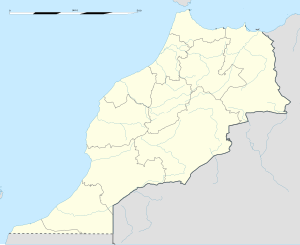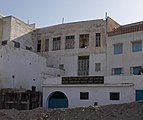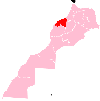Town in Casablanca-Settat, Morocco
Azemmour or Azammur (Arabic: أزمور, romanized: azammūr) is a Moroccan city, lying at the Atlantic ocean coast, on the left bank of the Oum Er-Rbia River, 75 km southwest of Casablanca.[1]
Etymology
The word Azemmour comes from the Berber word Azemmur ("wild olive tree").[2][3]
History
Azemmour is generally identified as the Punic Azama, latinized as Asama.
Before 1486, it was a dependency of the King of Fez. In 1486 its inhabitants became vassals and tributaries of João II of Portugal.[6]
In 1513 Azemmour's governor Moulay Zayam refused to pay the tribute and mustered a powerful, well-equipped army. Manuel responded to this challenge by sending a massive fleet of 500 ships and 15 thousand soldiers (Bergreen, 19). James, Duke of Braganza led this army and on September 1 he conquered the city with no resistance from its inhabitants. Ferdinand Magellan, the man famed for leading the first-ever circumnavigation of the earth, was among the Portuguese soldiers there; he lost his horse in skirmishes outside the city.[7] Portuguese control of the city lasted only for a short period; it was abandoned by João III of Portugal in 1541 due to his court's economic difficulties.[8]
Geography
Azemmour is located on the Oum Er-Rbia River 75 kilometres (47 mi) west of Casablanca.[1]
Azemmour's beach is a place for surfing and kitesurfing.[9] Also called Haouzia, the area's flora includes eucalyptus and pine.[10]
Culture
A spring festival used to be held annually in Azemmour in March. It was first held in 2007.[11] The patron saint of Azemmour is Abu Shuayb. His mausoleum was built on the order of Mohammed ben Abdallah. Each year, a moussem is celebrated to honour him. The Old City's walls are decorated by several local artists.[12] The city features a medina, which has three parts, a Jewish mellah, a kasbah, and the old medina.[1] A historic lighthouse called Sidi Boubeker is located 8 kilometres (5.0 mi) north of Azemmour.[10]
